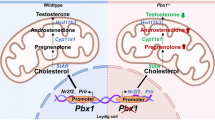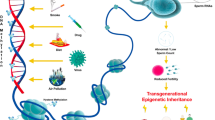Abstract
We developed a gonad cell line, CMgT-1, from the testes of Clarias magur in L-15 media with 20% FBS at 28 °C temperature and sub-cultured it more than 50 times. The origin of the cell line was validated using two universal markers, viz. cytochrome oxidase c subunit I and 16S rRNA genes. Cytogenetic analysis of the cells at 32nd passage revealed diploid chromosome number of 50. Immuno-phenotyping assay confirmed an epithelial-like cell type. The cell line was tested for mycoplasma contamination and found to be negative. The cells were successfully transfected with a GFP reporter gene that indicated that the cell line could be utilized in gene expression studies. The cell line was successfully utilized for evaluating cytotoxic effects of heavy metals, viz. potassium dichromate, mercury chloride and sodium (meta) arsenite, which reflects its potential applications in toxicity studies. CMgT-1 cell line will serve as a valuable resource for cytotoxicity and other in vitro studies.




Similar content being viewed by others
Availability of data and material (data transparency)
The deposited testis cell line CMgT-1 (Accession code: NRFC062) is presently available at National Repository of Fish Cell Lines (NRFC) at ICAR-National Bureau of Fish Genetic Resources (NBFGR), Lucknow, India for distribution to researchers for R&D works.
References
Bryson SP, Joyce EM, Martell DJ, Lee LE, Holt SE, Kales SC, Fujiki K, Dixon B, Bols NC. A cell line (HEW) from embryos of haddock (Melanogrammus aeglefinius) and its capacity to tolerate environmental extremes. Mar Biotechnol. 2006;8(6):641–53.
Castaño A, Bols N, Braunbeck T, Dierickx P, Halder M, Isomaa B, Kawahara K, Lee LE, Mothersill C, Pärt P, Repetto G. The use of fish cells in ecotoxicology: the report and recommendations of ECVAM Workshop 47. Altern Lab Anim. 2003;31(3):317–51.
Castano A, Gómez-Lechón MJ. Comparison of basal cytotoxicity data between mammalian and fish cell lines: a literature survey. Toxicol In Vitro. 2005;19(5):695–705.
Chen SL, Sha ZX, Ye HQ. Establishment of a pluripotent embryonic cell line from sea perch (Lateolabrax japonicus) embryos. Aquaculture. 2003;218(1–4):141–51.
Chen SL, Ye HQ, Sha ZX, Hong Y. Derivation of a pluripotent embryonic cell line from red sea bream blastulas. J Fish Biol. 2003;63(3):795–805.
Cheng CY, Mruk DD. The blood-testis barrier and its implications for male contraception. Pharmacol Rev. 2012;64(1):16–64.
Cheng TC, Lai YS, Lin IY, Wu CP, Chang SL, Chen TI, Su MS. Establishment, characterization, virus susceptibility and transfection of cell lines from cobia, Rachycentron canadum (L.), brain and fin. J Fish Dis. 2010;33(2):161–9.
Chi QQ, Zhu GW, Langdon A. Bioaccumulation of heavy metals in fishes from Taihu Lake. China Int J Environ Sci. 2007;19(12):1500–4.
Fan Z, Liu L, Huang X, Zhao Y, Zhou L, Wang D, Wei J. Establishment and growth responses of Nile tilapia embryonic stem like cell lines under feeder-free condition. Dev Growth Differ. 2017;59(2):83–93.
Fent K. Fish cell lines as versatile tools in ecotoxicology: assessment of cytotoxicity, cytochrome P4501A induction potential and estrogenic activity of chemicals and environmental samples. Toxicol In Vitro. 2001;15(4–5):477–88.
Freshney RI. Culture of animal cells—a manual of basic techniques. NewYork, NY, USA: Wiley-Liss; 2005. p. 641.
Gomez-Lechon MJ, Donato MT, Lahoz A, Castell JV. Cell lines: a tool for in vitro drug metabolism studies. Curr Drug Metab. 2008;9(1):1–11.
Higaki S, Shimada M, Koyama Y, Fujioka Y, Sakai N, Takada T. Development and characterization of an embryonic cell line from endangered endemic cyprinid Honmoroko Gnathopogon caerulescens (Sauvage, 1883). Vitro Cell Dev Biol Anim. 2015;51(8):763–8.
Lee D, Kim MS, Nam YK, Kim DS, Gong SP. Establishment and characterization of permanent cell lines from Oryzias dancena embryos. Fish Aquat Sci. 2013;16(3):177–85.
Lio-Po GD, Traxler GS, Albright LJ. Establishment of cell lines from catfish (Clarias batrachus) and snakeheads (Ophicephalus striatus). Asian Fish Sci. 1999;12(4):343–9.
Ng HH, Kottelat M. The identity of Clarias batrachus (Linnaeus, 1758), with the designation of a neotype (Teleostei: Clariidae). Zool J Linn Soc. 2008;153(4):725–32.
Palumbi SR, Martin A, Romano S, McMillan WO, Stice L, Grabowski G (1991) The simple fool’s guide to PCR. Honolulu: Department of Zoology, University of Hawaii, p 47
Rani MJ, Milton JMC, Uthiralingam M, Azhaguraj R. Acute toxicity of mercury and chromium to Clarias batrachus (Linn). Bioresearch Bull. 2011;1:104–8.
Rathore G, Kumar G, Swaminathan TR, Sood N, Singh VI, Abidi R, Lakra WS. Primary cell culture from fin explants of Labeo rohita (Ham). Indian J Fish. 2007;541:93–7.
Ristow SS, de Avila J. Susceptibility of four new salmonid cell lines to infectious hematopoietic necrosis virus. J Aquat Anim Health. 1994;6(3):260–5.
Shimizu C, Shike H, Malicki DM, Breisch E, Westerman M, Buchanan J, Ligman HR, Phillips RB, Carlberg JM, Van Olst J, Burns JC. Characterization of a white bass (Morone chrysops) embryonic cell line with epithelial features. Vitro Cell Dev Biol Anim. 2003;39(1–2):29–35.
Sobhana KS, George KC, Venkat Ravi G, Ittoop G, Paulraj R. Development of a cell culture system from gill explants of the grouper, Epinephelus malabaricus (Bloch and Shneider). Asian Fish Sci. 2009;22(2):541–7.
Soni P, Pradhan PK, Swaminathan TR, Sood N. Development, Repository and application of a new epithelial cell line from caudal fin of Pangasianodon hypophthalmus (Sauvage 1878). Acta Trop. 2018;182:215–22.
Sood N, Chaudhary DK, Pradhan PK, Verma DK, Swaminathan TR, Kushwaha B, Punia P, Jena JK. Establishment and characterization of a continuous cell line from thymus of striped snakehead, Channa striatus (Bloch 1793). Vitro Cell Dev Biol Anim. 2015;51(8):787–96.
Sun A, Zhu H, Dong Y, Wang W, Hu HX. Establishment of a novel testicular cell line from sterlet Acipenser ruthenus and evaluation of its applications. J Fish Biol. 2019;94(5):804–9.
Uphoff CC, Drexler HG. Detection of mycoplasma contamination in cell cultures. Curr Protoc Mol Biol. 2014;106(1):28–34.
Vishwanath W. Clariasmagur: IUCN (2012) IUCN Red List of Threatened Species. Version 2012.2.http://www.iucnredlist.org/details/166613/0. Accessed 25 Jan 2016
Vo NT, Sansom B, Kozlowski E, Bloch S, Lee LE. Development of a permanent cell line derived from fathead minnow testis and their applications in environmental toxicology. MDIBL Bull. 2010;49:83–6.
Wang XL, Wang N, Sha ZX, Chen SL. Establishment, characterization of a new cell line from heart of half smooth tongue sole (Cynoglossus semilaevis). Fish Physiol Biochem. 2010;36(4):1181–9.
Ward RD, Zemlak TS, Innes BH, Last PR, Hebert PD. DNA barcoding Australia’s fish species. PHILOS T R SOC B. 2005;360(1462):1847–57.
Zhang B, Wang X, Sha Z, Yang C, Liu S, Wang N, Chen SL. Establishment and characterization of a testicular cell line from the half-smooth tongue sole, Cynoglossus semilaevis. Int J Biol Sci. 2011;7(4):452.
Acknowledgements
The authors are thankful to the Director, ICAR-NBFGR, Lucknow, for support and providing the necessary facilities to carry out this work. The financial assistance granted by the Department of Biotechnology, Government of India, New Delhi, India, vide Sanction Order No. BT/PR13908/AAQ/3/733/2015 is duly acknowledged. The first author is also thankful to Dr. M. Goswami, Principal Scientist, ICAR-CIFE, Mumbai and former faculty of ICAR-NBFGR, Lucknow for his support.
Funding
The present work was carried out under a research project funded by the Department of Biotechnology, Government of India, New Delhi, India, vide Sanction Order No. BT/PR13908/AAQ/3/733/2015 dated May 10, 2017.
Author information
Authors and Affiliations
Contributions
NS: Conducted main experimentation, culture setup and manuscript draft preparation, PS: Assisted in cell culture and immuno-phenotyping, BK: Conceptualization, planning, supervision and manuscript preparation, MSK: Experiment designing and cell culture characterization, JKS: Supervision and manuscript editing, SS: Explant preparation and karyotyping, AKM: Sequencing and characterization, RK: Manuscript editing and proof reading.
Corresponding author
Ethics declarations
Conflict of interest
The authors declare that there is no conflict of interest in the present study.
Ethics approval
The guidelines issued by the Government of India for control and supervision of experiments on animals was followed strictly while handling the fish specimen. The present study was also approved by the Institute Animal Ethics Committee (IAEC) constituted by the Committee for the Purpose of Control and Supervision of Experiments on Animals (CPCSEA), New Delhi, India.
Additional information
Corresponding Editor : Rabindra Nath Chatterjee
Publisher's Note
Springer Nature remains neutral with regard to jurisdictional claims in published maps and institutional affiliations.
Rights and permissions
About this article
Cite this article
Singh, N., Soni, P., Kushwaha, B. et al. Establishment of a testis cell line from Clarias magur: a potential resource for in-vitro applications. Nucleus 64, 211–217 (2021). https://doi.org/10.1007/s13237-020-00345-w
Received:
Accepted:
Published:
Issue Date:
DOI: https://doi.org/10.1007/s13237-020-00345-w




